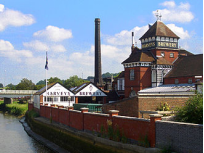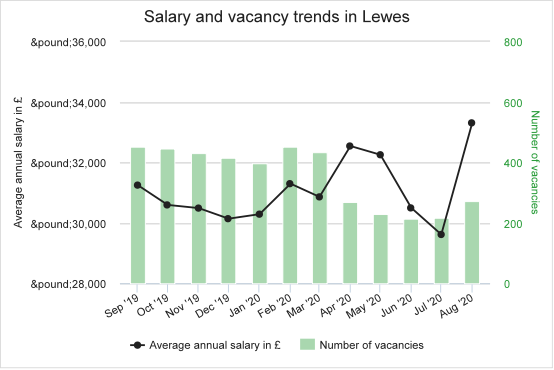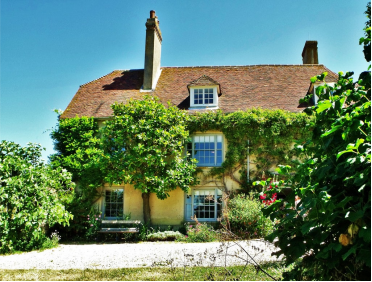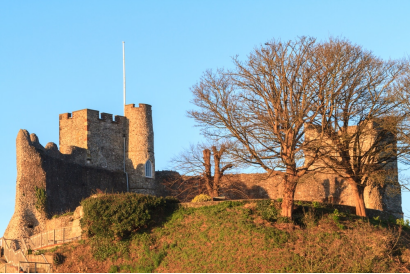Lewes, East Sussex, England, UK 作者: 来源: 发布时间:2021-07-26
I. Population and Area
Continent: Europe
Country: The U.K
State/Province: England
City/Town: Lewes, East Sussex
Total Area: 4.4 (sq mi)
Population in 2018 : 17.3 (thousand)

II. Natural Geography (environment and resources)
Climate
Lewes is situated on the Greenwich or Prime Meridian, in a gap in the South Downs, cut through by the River Ouse, and near its confluence with the Winterbourne Stream. It is approximately seven miles north of Newhaven, and an equal distance north-east of Brighton. The South Downs rise above the river on both banks. The High Street, and earliest settlement, occupies the west bank, climbing steeply up from the bridge taking its ancient route along the ridge; the summit on that side, 2.5 miles (4 km) distant is known as Mount Harry. On the east bank there is a large chalk cliff Cliffe Hill that can be seen for many miles, part of the group of hills including Mount Caburn, Malling Down (where there are a few houses in a wooded area on the hillside, in a development known as Cuilfail) and Golf Hill (home to the Lewes Golf Club). The two banks of the river are joined by Willey's Bridge (a footbridge), the Phoenix Causeway (a recent concrete road bridge, named after the old Phoenix Ironworks) and Cliffe Bridge (an 18th-century replacement of the mediaeval crossing, widened in the 1930s and now semi-pedestrianised).
Road
Lewes, from its inception, has been an important transport hub. Its site as a bridging point was probably originally a ford: today the main routes avoid the town centre. The A27 trunk road taking traffic along the south coast between Eastbourne and Southampton passes to the south of the town. The A26 from Maidstone to Newhaven; and the A275 (the London road) both come in from the north. The Brighton & Hove bus company and Compass Travel serve the town. The bus station was closed for a while but reopened in late 2008.
Rail
Lewes railway station was originally the junction for six routes. The town still enjoys hourly fast trains from London. The two erstwhile rural rail routes to the north, linking to East Grinstead and Uckfield respectively, are both now closed, but the East Coastway Line, connecting Brighton with Eastbourne and Hastings, and the branch to Seaford remain.
Bus
The Vanguard Way, a long-distance footpath from London to Newhaven, passes through countryside east of the town. The South Downs Way also passes close to Lewes, crossing the Ouse at Southease, some four miles south of the town. The Greenwich Meridian Trail, a long-distance path that follows the Greenwich Meridian from Peacehaven in East Sussex to Sand le Mere in East Yorkshire passes through the middle of the town. A festival celebrating and encouraging walking and cycling, the Lewes Hike and Bike Festival, was created in 2012 but only ran for three years. The Eastbourne and Lewes Walking Festival was created in 2018 to promote walking in the local urban and rural South Downs area.

III. Economy
Rank | Place | Per Capita Income |
12 | Lewes | $32,685 |
You're viewing live stats for Lewes vacancies from our database of over 1 million job ads. Here are some fast facts:
· The average Lewes salary is £31,502.
· Currently there are 262 live job ads in Lewes, out of 496,493 jobs nationally.
· Most live job ads in Lewes are for Healthcare & Nursing Jobs and Trade & Construction Jobs.
· Salaries in Lewes have gone up 6.6% year-on-year while the national annual change is 2.4%
· The top companies hiring in Lewes are East Sussex County Council, Care UK and Spencer Stuart.

Reference Website:
https://www.adzuna.co.uk/jobs/salaries/lewes
IV. Industrial Characterisitics
Major industries:
Lewes is a market town of small, specialist, independent retailers and on certain days, the subtle aromas wafting from Harvey’s Brewery will attract any visitor to Cliffe High Street. Bookshops, boutiques and antique centres sit alongside individual craft workshops, and the restaurants, cafes, and pubs offer delicious choices all year round with real emphasis on local produce.
A historic assize town, Lewes in modern times has developed as the county town (seat) of East Sussex. Tourism is important to the economy (though tourists are generally discouraged from attending the Guy Fawkes Day celebrations), and there are some light industries. Glyndebourne, the world-famous opera centre, is only 3 miles (5 km) from the town.
Major projects and related introductions:
The Big Parks Project
The Big Parks Project was set up in 2011 to deliver improved recreation and leisure facilities in Peacehaven. The project was funded by financial contributions from developments in Peacehaven and grant funding from Veolia Environmental, Southdowns National Park Authority and the Children’s Health Fund. Consultations were set up with the community to find out what was needed and wanted by the local people. The project board comprised representatives from Lewes District Council, Peacehaven Town Council, East Sussex County Council and Peacehaven Community School. The board made key decisions for the project and the day to day project management was carried out by Lewes District Council. Following an extensive public consultation, it became clear that residents wanted a place to play, walk and cycle, a place to meet their friends. A Masterplan was then drawn up for the park by landscape architects Allen Scott Ltd and architects Kaner Olette. The plan included improved sports facilities, skate park, a central activity hub with café, and open space and recreation areas suitable for all sections of the community. The park is of significant archaeological interest and so the café was designed to incorporate an interpretation space to accommodate some of the artifacts found at the site. Additionally the park adjoins the South Downs National Park and provides a gateway to exploring the wider countryside, this was also taken into consideration when considering the look and feel of the development.
Reference Website:
http://bigparksproject.org.uk/about-2/
https://www.britannica.com/place/Lewes-England
V. Attractions
1. Charleston:

The artist couple Vanessa Bell and Duncan Grant picked this large farmhouse in the village of Firle as their country home in 1916. Over the next 50 years the house would be a meeting place for the Bloomsbury group, a set of forward-thinking artists, writers and intellectuals made up of the likes of Virginia Woolf and T. S. Eliot.
2. Lewes Castle:

A Norman motte-and-bailey stronghold, Lewes Castle was built within three years of the Battle of Hastings (1066), and for most of the Medieval period was controlled by the Earls of Surrey, descendants of the nobleman William de Warenne who fought at the battle.
3. Cliffe High Street:

Cliffe High Street is on a bit of a slope, with a pedestrianised section at the top and a few narrow lanes and passages disappearing off to the sides. On this upper stretch there are views of the South Downs to stop you in your tracks, as well as a farmers’ market on the first and third Saturdays of the month.
Reference Website:
https://www.thecrazytourist.com/15-best-things-to-do-in-lewes-east-sussex-england/
VI. History
Archaeological evidence points to prehistoric dwellers in the area. Scholars think that the Roman settlement of Mutuantonis was here, as quantities of artefacts have been discovered in the area. The Saxons built a castle, having first constructed its motte as a defensive point over the river; they gave the town its name.
The place-name 'Lewes' is first attested in an Anglo-Saxon charter circa 961 AD, where it appears as Læwe and Laewes. It appears as Lewes in the Domesday Book of 1086. The name means 'hills', from the Old English hlæw meaning 'hill'.
After the Norman invasion, William the Conqueror rewarded William de Warenne, 1st Earl of Surrey, with the Rape of Lewes, a swathe of land along the River Ouse from the coast to the Surrey boundary. He rebuilt Lewes Castle on the Saxon site; and he and his wife, Gundred also founded the Priory of St Pancras, a Cluniac monastic house, in about 1081. Lewes was the site of a mint during the Late Anglo-Saxon period and thereafter a mint during the early years after the Norman invasion. In 1148 the town was granted a charter by King Stephen. The town became a port with docks along the River Ouse.[citation needed]
The town was the site of the Battle of Lewes between the forces of Henry III and Simon de Montfort in the Second Barons' War in 1264, at the end of which de Montfort's forces were victorious and rebuilt the castle. Simon the Monfort rebuilt the castle. The battle took place in fields now just west of Landport. (Professor David Carpenter gave a lecture about the Battle of Lewes at Lewes Town Hall in the summer of 2010; it can be heard at the following website.)
At the time of the Marian Persecutions of 1555–1557, Lewes was the site of the execution of seventeen Protestant martyrs, who were burned at the stake in front of the Star Inn. A memorial to the martyrs was unveiled on Cliffe Hill in 1901. Through the 17th and 18th centuries, Lewes developed as the county town of Sussex, expanding beyond the line of the town wall. It was an active port and developed related iron, brewing, and ship building industries.
In 1846 the town became a railway junction, with lines constructed from the north, south and east to two railway stations. The development of Newhaven ended Lewes's period as a major port. During the Crimean War, some 300 Finns serving in the Russian army captured at Bomarsund were imprisoned at Lewes. Lewes became a borough in 1881. Lewes Town Hall opened in 1893 in premises converted from the former Star Inn and in 1913 Council Offices were added in Arts-and-Crafts style.
Lewes Victoria Hospital opened in 1909 in its current premises, as Victoria Hospital and Infirmary, having previously been on School Hill where it opened as the Lewes Dispensary and Infirmary in 1855.
VII. Culture
Located four miles (6 km) outside of Lewes is Glyndebourne opera house. Founded in 1934, the venue draws large audiences for its Summer Festival and has attracted a host of international talent throughout its history. Lewes Operatic Society (founded 1911) and New Sussex Opera are also based in the town of Lewes.
A number of other local classical music series operate in the town, including the Nicholas Yonge Society and the baroque and early classical Workshop Series. The Musicians of All Saints is a Lewes-based chamber orchestra founded in 1987 who perform both new works and standard repertoire. A new annual music series, the Lewes Chamber Music Festival,was created in summer 2012. Other local music groups include the Lewes Concert Orchestra founded in 1993; and the Lewes, Glynde and Beddingham Brass Band, founded in 1922.
The East Sussex Bach choir is based in Lewes, as well as a number of other active amateur choirs, including Pro Musica Chamber Choir, the Everyman Ensemble, the Paddock Singers, Lewes Vox and East Sussex Community Choir.[89]
The principal town museum is Barbican House Museum at Lewes Castle, which hosts the Lewes Town Model as well as four galleries of Sussex archaeology. Anne of Cleves House has various collections relating to the history of Lewes. There are several independent art galleries in the town including the Martyrs Gallery in the former Star Brewery in Market Street; St Anne's Gallery in the High Street and occasional art exhibitions mounted at the Town Hall. Other galleries are listed in Gallery Guide Lewes and Art Map Lewes.
Lewes Little Theatre was created in 1939 and is based in dedicated premises on Lancaster Street. It puts on half a dozen or more productions each year. Supporters of the creation of the Theatre include John Maynard Keynes.
A new independent three-screen cinema, the Lewes Depot, opened in May 2017 in a multimillion-pound redevelopment of a former Harvey's brewery depot close to Lewes station.The architects were Burrell Foley Fischer and the work was given a Friends of Lewes award, and highly commended in the South Downs National Park design awards. The Lewes Film Club, which also produces short movies (including the recent adaptation of George Orwell's Animal Farm), and Film at All Saints' (the Film Club in collaboration with Lewes Town Council), show films based in the All Saints' Centre, a former church.
Local dance schools and clubs include Lewes Dance Club, East Sussex Dance and ballet groups. Starfish Youth Music[99] is based at Priory School and the young bands who take part regularly perform in local venues such as the Paddock and the All Saints' Centre.
Popular music gigs take place at a number of venues and pubs across the town including the Lewes Con Club, the Snowdrop Inn, the Volunteer pub, the Lewes Arms, the John Harvey Tavern, the Pelham Arms, the Lamb and the Lansdown. The Elephant and Castle hosts the Saturday Folk Club. Union Music Store based in Lewes has become a centre for modern folk, country and Americana, both promoting and hosting live gigs, and recording and producing local musicians. A monthly comedy club based at the Con Club was created in 2010.
A regular local music festival, Lewes Live (previously Rock in the Bog), takes place in the summer. The town of Lewes was also the UK location for the Mumford and Sons' Gentlemen of the Road tour stopover in 2013. A large jazz festival, Love Supreme Festival was founded in 2013 at nearby Glynde Place. Other local festivals include the Brainchild Festival, based just north of Lewes in the grounds of Bentley Wildfowl and Motor Museum]
Annual arts events include ArtWave and the children's Patina Moving on Parade. An annual Lewes Guitar Festival which started in 1999 has not operated since the late 2000s. The annual Charleston Festival is hosted at nearby Charleston Farmhouse near the village of Firle some 6 miles east of Lewes.
VIII. Other information
The Sussex Express newspaper (formally the Sussex Express and County Herald) was established in 1837 in Lewes as the Sussex Agricultural Express and merged with the Sussex County Herald in 1938. Now headquartered in Horsham, it serves Lewes and much of East Sussex. It has four editions and includes extensive coverage of the local sports scene. It is part of the Johnston Press network of newspapers.
Viva Lewes was founded as a weekly web magazine in January 2006 and also as a monthly print handbook in October 2006 covering events and activities in and around the Lewes area.
In December 2018 a monthly lifestyle publication Town & County Magazine was launched, with coverage of local life, history, and culture, and celebrity interviews, across Lewes district as well as Alfriston & Ditchling.
Bright 106.4 FM radio station, based in Burgess Hill, broadcasts to an area which extends to Lewes.
Lewes has its own RSL radio station, Rocket FM, which broadcasts via FM and the Internet for three weeks in October/November each year, covering the Bonfire period.
In November 2012, EE launched a series of advertisements promoting its 4G mobile service. All of the adverts, which featured actor Kevin Bacon, were filmed in Lewes.
IX. Contact information
Mayor/Officer: Cllr John Lamb
Tel: 0345 6080190
Mail: @EastSussexCC(twitter)
Reference Website:
